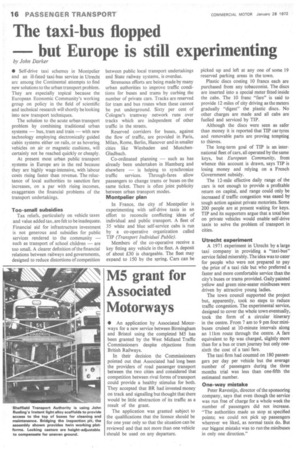The taxi-bus flopped but Europe is still experimenting
Page 18

If you've noticed an error in this article please click here to report it so we can fix it.
by John Darker
• Self-drive taxi schemes in Montpelier and an ill-fated taxi-bus service in Utrecht are among the Continental attempts to find new solutions to the urban transport problem. They are especially topical because the European Economic Community's working group on policy in the field of scientific and technical research will shortly be looking into new transport techniques.
The solution to the acute urban transport problem by combining traditional urban systems — bus, tram and train — with new technology employing electronically guided cabin systems either on rails, or as hovering vehicles on air or magnetic cushions, will certainly not be reached quickly or cheaply.
At present most urban public transport systems in Europe are in the red because they are highly wage-intensive, with labour costs rising faster than revenue. The reluctance of local authorities to sanction fare increases, on a par with rising incomes, exaggerates the financial problems of the transport undertakings.
Too-small subsidies Tax reliefs, particularly on vehicle taxes and value added tax, are felt to be inadequate. Financial aid for infrastructure investment is not generous and subsidies for public services rendered to the community — such as transport of school children — are too small. A clearer definition of the financial relations between railways and governments, designed to reduce distortions of competition
between public local transport undertakings and State railway systems, is overdue.
Strenuous efforts are being made by many urban authorities to improve traffic conditions for buses and trams by curbing the number of private cars. Tracks are reserved for tram and bus routes when these cannot be put underground. Sixty per cent of Cologne's tramway network runs over tracks which are independent of other traffic in the streets.
Reserved corridors for buses, against the flow of traffic, are provided in Paris, Milan, Rome, Berlin, Hanover and in smaller cities like Wiesbaden and MunchenGladbach.
Co-ordinated planning — such as has already been undertaken in Hamburg and elsewhere — is helping to synchronize traffic services. Through-fares allow passengers to change trams or buses on the same ticket. There is often joint publicity between urban transport modes.
Montpelier plan
In France, the city of Montpelier is experimenting with self-drive taxis in an effort to reconcile conflicting ideas of individual and public transport. A fleet of 35 white and blue self-service cabs is run by a co-operative organization called TIP (Transport Individuel Public).
Members of the co-operative receive a key fitting any vehicle in the fleet. A deposit of about £30 is chargeable. The fleet may expand to 150 by the spring. Cars can be picked up and left at any one of some 19 reserved parking areas in the town.
Plastic discs costing 10 francs each are purchased from any tobacconist. The discs are inserted into a special meter fitted inside the cabs. The 10 franc "fare" is said to provide 12 miles of city driving as the meters gradually "digestthe plastic discs. No other charges are made and all cabs are fuelled and serviced by TIP.
Although the discs were seen as safer than money it is reported that TIP car tyres and removable parts are proving tempting to thieves.
The long-term goal of TIP is an international fleet of cars, all operated by the same keys, but European Community, from whence this account is drawn, says TIP is losing money and relying on a French Government subsidy.
The 12-mile effective daily range of the cars is not enough to provide a profitable return on capital, and range could only be increased if traffic congestion was eased by tough action against private motorists. Some 200 people are at present waiting for keys. TIP and its supporters argue that a total ban on private vehicles would enable 'self-drive taxis to solve the problem of transport in cities.
Utrecht experiment A 1971 experiment in Utrecht by a large taxi company in providing a "taxi-bus" service failed miserably. The idea was to cater for people who were not prepared to pay the price of a taxi ride but who preferred a faster and more comfortable service than the city's buses or trams provided. Gaily painted yellow and green nine-seater minibuses were driven by attractive young ladies.
The town council supported the project but, apparently, took no steps to reduce traffic congestion. The experimental service, designed to cover the whole town eventually, took the form of a circular itinerary in the centre. From 7 am to 9 pm four minibuses cruised at 10-minute intervals along an 11km route through the centre. A fare equivalent to 8p was charged, slightly more than for a bus or tram journey but only onesixth the cost of a taxi fare.
The taxi firm had counted on 180 passengers per day per vehicle but the average number of passengers during the three months trial was less than one-fifth the estimated number.
One-way mistake
Peter Ravestijn, director of the sponsoring company, says that even though the service was run free of charge for a whole week the number of passengers did not increase. "The authorities made us stop at specified points; we could not pick up passengers wherever we liked, as normal taxis do. But our biggest mistake was to run the minibuses in only one direction."
























































































